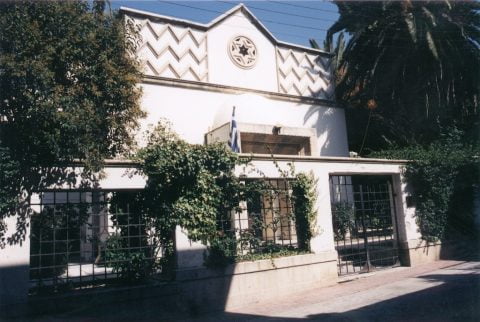
A nighttime tour of the Old and New Jewish cemeteries, in Eisenstadt. Bring a flashlight!
Of the older cemetery, in used from 1679 to 1874, can be considered one of the most important Jewish cemeteries in Europe. The newer cemetery, used until 1938, tells stories about the last decades of Jewish life in Eisenstadt.

Guided tour of the Wertheimer synagogue, accessible as part of the Austrian Jewish Museum. Dedicated to Jewish life in the province of Burgenland, the museum opened in 1982 in the former mansion of Samson Wertheimer (1659-1724). The private synagogue is part of the mansion.
Wertheimer had a prominent role at the Viennese court, where from 1694 to 1709 he worked for emperors Leopold I, Joseph I, and Charles VI as Hofoberfaktor or chief administrator of financial affairs. He also served the Esterhazy family in Burgenland and was Rabbi of Hungary and Moravia.
A mob destroyed Eisenstadt’s main synagogue on Kristallnacht in 1938 but the they overlooked the Wertheimer Shul, hidden in the mansion. The synagogue was re-consecrated for Jewish worship in 1979.
In its current form the synagogue dates almost entirely from 1832, having been refurbished after the Eisenstadt ghetto was badly damaged in a fire of 1795. Its design includes many elements typical of the period, including a high ceiling and a chandelier hanging from a painted rosette. At the inauguration of the building in 1834, members of the community contributed ceremonial silver, a painted glass beaker for the Hevrah Kadisha (Burial Society), Torah scrolls, an elaborate Parohet (Ark curtain) and a parchment Megillah (Scroll of the Book of Esther) executed by the scribe Elie Gabriel, all of which are among the items displayed in the museum today.

Online lecture by Leon Saltiel on his research on the destruction of the Jewish cemetery of Thessaloniki (Salonika), Greece.
The lecture is sponsored by the @UCLA Stavros Niarchos Foundation Center.


Lecture by Michael Miller, of CEU
Budapest is sometimes called the “Paris of the East,” but in the 1890s, it acquired a new, less flattering nickname: “Judapest.” Karl Lueger, the antisemitic mayor of Vienna – who hated Hungarians more than he hated Jews – is often credited with coining this derogatory nickname for a city that he thought had become more “Jewish” than “Hungarian.” Budapest was Europe’s fastest-growing city at the time, with a flurry of cultural and commercial activity that fascinated — and sometimes appalled — contemporary residents and visitors. This talk will examine the image of Budapest in the decades before and after the First World War, exploring the ways in which Hungary’s capital city was imagined by Jews and non-Jews alike as a quintessentially Jewish metropolis.
The evening will be chaired by Professor Mark E. Smith, President and Vice-Chancellor of the University of Southampton. It will be hosted by Professor Mark Cornwall (University of Southampton, Parkes Institute)
The event will be held on Zoom. Please register by Monday 19th April 16:00 here:
https://www.southampton.ac.uk/parkes/news/events/2021/04/20-parkes-lecture-2021.page
Speaker biography: Michael L. Miller is Associate Professor in the Nationalism Studies Program at Central European University in Budapest, Hungary, and co-founder of the university’s Jewish Studies program. He received his PhD in History from Columbia University, where he specialized in Jewish and Central European History. Michael’s research focuses on the impact of nationality conflicts on the religious, cultural, and political development of Central European Jewry in the long nineteenth century. His articles have appeared in Slavic Review, Austrian History Yearbook, Simon Dubnow Institute Yearbook, Múlt és Jövő , The Jewish Quarterly Review and AJS Review. Miller’s book, Rabbis and Revolution: The Jews of Moravia in the Age of Emancipation, was published by Stanford University Press in 2011. It appeared in Czech translation as Moravští Židé v době emancipace (Nakladatelství Lidové noviny, 2015). He is currently working on a history of Hungarian Jewry, titled Manovill: A Tale of Two Hungarys.

Baden bei Wien – Baden by Vienna – was long a popular spa and summer guests were originally attracted by the glamorous presence of the Imperial Court.
Many of these families who spent their summers in Baden had Jewish roots. They built villas in a variety of styles – historicist, art nouveau and modernist – a fascinating mixture and shaped summer life in Baden until 1938.
This exhibition is dedicated to ten families and their villas.
Click here for an interactive map with the villas

Inauguration of the restored synagogue on the island of Kos.
A new Ark and Bimah and other interior furnishings have been installed and — after decades out of its original use — the building will be rededicated as an active house of Jewish worship.
The Kos synagogue was built in the mid-1930s to replace an older synagogue that was destroyed in an earthquake in April 1933. It was abandoned after the near-total destruction of the circa 120 member Jewish community during the Holocaust, and then was purchased by the Municipality around 1984 and used as a local cultural centre.

Presenting a selection of nearly 150 pieces from various sources, this photographic exhibition recreates the history of Salonika (today Thessaloniki) Greece from the second half of the 19th century to the end of the First World War. Men and women are captured in their traditional costumes: modest artisans, porters, traders, members of the local “aristocracy;” society is revealed. Urban modernization is also shown: the quays and the White Tower, cafes, restaurants and entertainment venues; the Countryside sector where the notables established their residence; deprived areas, where emerging industries were established.
But also, in the now Greek city, the great fire of August 1917, an authentic trauma for the Jews who saw their historic neighborhoods, the municipal archives and more than thirty synagogues swept away by the flames, before the geopolitical upheavals caused by the First War worldwide.



Comments are closed.